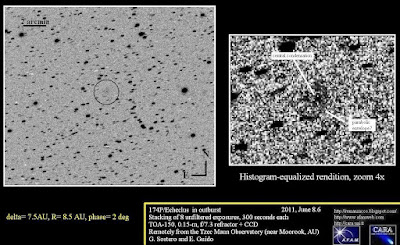Following the recent outburst of centaur 174P/Echeclus, we performed some follow-up of this intriguing object. Stacking of 8 unfiltered exposures 300 sec each, obtained remotely, from the Tzec Maun Observatory (near Moorook, Australia) on 2011, June 8.6, through a 0.15-m, f/7.3 refractor + CCD, shows some evolution within the coma of this object: we detected the development of a (possible) faint parabolic envelope about 45-arcsec in diameter, with the central condensation having an offset of nearly 13-arcsec to the west-southwest.
Our image (click on the image for a bigger version):

Unfortunately in our image the S/N of this feature is pretty low, so further follow-up and confirming images will be very welcome.
UPDATE - June 10, 2011
UPDATE - June 10, 2011
Thanks to our fellow british observer Nick Howes, today we had the opportunity to image 174P/Echeclus nearly simultaneously with both the 2-m Faulkes Telescopes, under excellent seeing conditions, from Haleakala (Hawaii) and Siding Spring (Australia).
Stacking of R-filtered exposures for a total of 930 sec, obtained remotely, from the Haleakala-Faulkes Telescope North on 2011, June 10.4, through a 2.0-m f/10.0 Ritchey-Chretien + CCD under good seeing conditions, confirms the presence of a parabolic envelope, having 47-arcsec in diameter, and a broad tail (or a train of debrises) nearly 20-arcsec long and about 5-arcsecwide, toward PA 70. The nuclear condensation m2 has dropped to R about 19. Confirming observations of the above mentioned features were obtained nearly simultaneously with the Siding Spring-Faulkes Telescope South.
Below you can see our combined image of the two observing sessions, for an equivalent total exposure time of 1530 seconds, R-filtered (click on the image for a bigger version)

Stacking of R-filtered exposures for a total of 930 sec, obtained remotely, from the Haleakala-Faulkes Telescope North on 2011, June 10.4, through a 2.0-m f/10.0 Ritchey-Chretien + CCD under good seeing conditions, confirms the presence of a parabolic envelope, having 47-arcsec in diameter, and a broad tail (or a train of debrises) nearly 20-arcsec long and about 5-arcsecwide, toward PA 70. The nuclear condensation m2 has dropped to R about 19. Confirming observations of the above mentioned features were obtained nearly simultaneously with the Siding Spring-Faulkes Telescope South.
Below you can see our combined image of the two observing sessions, for an equivalent total exposure time of 1530 seconds, R-filtered (click on the image for a bigger version)

by Giovanni Sostero & Ernesto Guido

1 comment:
Hi,
We Xingming Observatory also took some images of 174P on Jun 07, as you could see my results are here: http://comethunter.lamost.org/scwrk/APW/174P/174P.htm#20110607
My measurement of the remnant's diameter and the central condensation's offset are close to yours. Unluckily this year the weather was unusually nasty so we couldn't make day-to-day follow up observations of development of the remnant.
Cheers,
Man-To Hui
Post a Comment